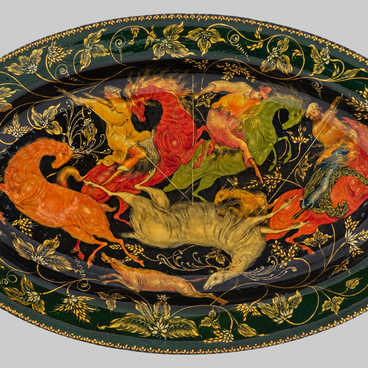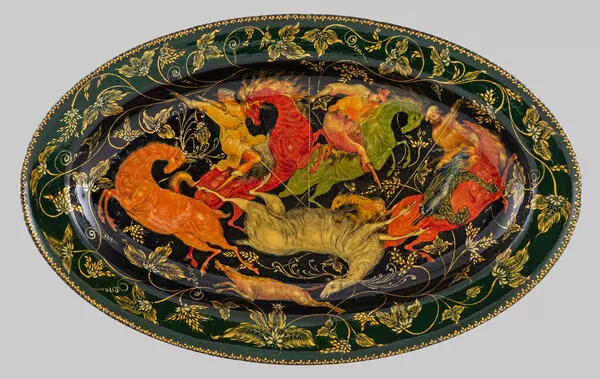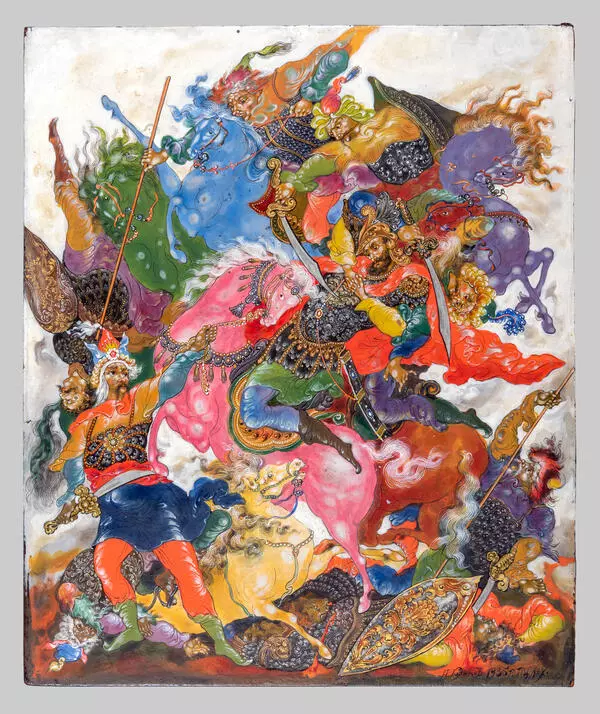Ivan Golikov created the ‘Stepan Razin Addresses the Poor’ wooden board miniature in 1924. The artist was one of the forefathers of the Palekh lacquer miniature. Old-timers said that Ivan Golikov was a barely literate. He, however, possessed an exceptional intuition and a profound talent for new art.
The Palekh lacquer miniature is derived from icon painting. The village used to be famous for its icon painters, but after the October Revolution local masters had to abandon the biblical plots — the USSR did not look kindly upon the Christian faith. The artists applied their cumulative experience to a new form — lacquer miniature. This new form was focusing on man.
In the early days of his artistic career, Ivan Golikov was creating mostly unremarkable compositions of lines and ornaments. Although later on, he would move on to more complex semantic and rhythmic solutions. In his artworks, he mostly depicted real historical characters. The artist conveyed their personalities with tremendous accuracy.
In ‘Stepan Razin Addresses the Poor’, Ivan Golikov portrayed the famous ataman. Here, the hero is the leader of the serf uprising of 1670–1671. The artist depicted him as a chieftain and a talented public speaker who could move people to support his cause. The artist captured his energetic personality quite convincingly.
Each character depicted received a number of psychological traits: among Stepan Razin’s followers there are young people, there are warriors looking forward to the next battle, and there are brave fellows how would never accept any other life than a life of total freedom. The artist arranged these figures in a complex rhythmic order.
For the residents of Palekh, Razin was, firts and foremost, a hero from the folk songs. To the artist himself, Razin was more of a folklore character, which is why he painted him and those close to him in fairytale clothes. This is one of the few artworks painted by the artist where the landscape plays an important role in the composition.
The technique he used to create this artwork is a carryover from the icon painting tradition. The artist used a face painting technique often found in his other works — the expressions are created with the moving color mass, and the volume is created with color fusion. When fusing colors, artists apply the paint in thin layers, starting with the darker tones and moving on to progressively lighter ones. This allows for a perceived depth effect and smooth transitions within volumes.
The Palekh lacquer miniature is derived from icon painting. The village used to be famous for its icon painters, but after the October Revolution local masters had to abandon the biblical plots — the USSR did not look kindly upon the Christian faith. The artists applied their cumulative experience to a new form — lacquer miniature. This new form was focusing on man.
In the early days of his artistic career, Ivan Golikov was creating mostly unremarkable compositions of lines and ornaments. Although later on, he would move on to more complex semantic and rhythmic solutions. In his artworks, he mostly depicted real historical characters. The artist conveyed their personalities with tremendous accuracy.
In ‘Stepan Razin Addresses the Poor’, Ivan Golikov portrayed the famous ataman. Here, the hero is the leader of the serf uprising of 1670–1671. The artist depicted him as a chieftain and a talented public speaker who could move people to support his cause. The artist captured his energetic personality quite convincingly.
Each character depicted received a number of psychological traits: among Stepan Razin’s followers there are young people, there are warriors looking forward to the next battle, and there are brave fellows how would never accept any other life than a life of total freedom. The artist arranged these figures in a complex rhythmic order.
For the residents of Palekh, Razin was, firts and foremost, a hero from the folk songs. To the artist himself, Razin was more of a folklore character, which is why he painted him and those close to him in fairytale clothes. This is one of the few artworks painted by the artist where the landscape plays an important role in the composition.
The technique he used to create this artwork is a carryover from the icon painting tradition. The artist used a face painting technique often found in his other works — the expressions are created with the moving color mass, and the volume is created with color fusion. When fusing colors, artists apply the paint in thin layers, starting with the darker tones and moving on to progressively lighter ones. This allows for a perceived depth effect and smooth transitions within volumes.









